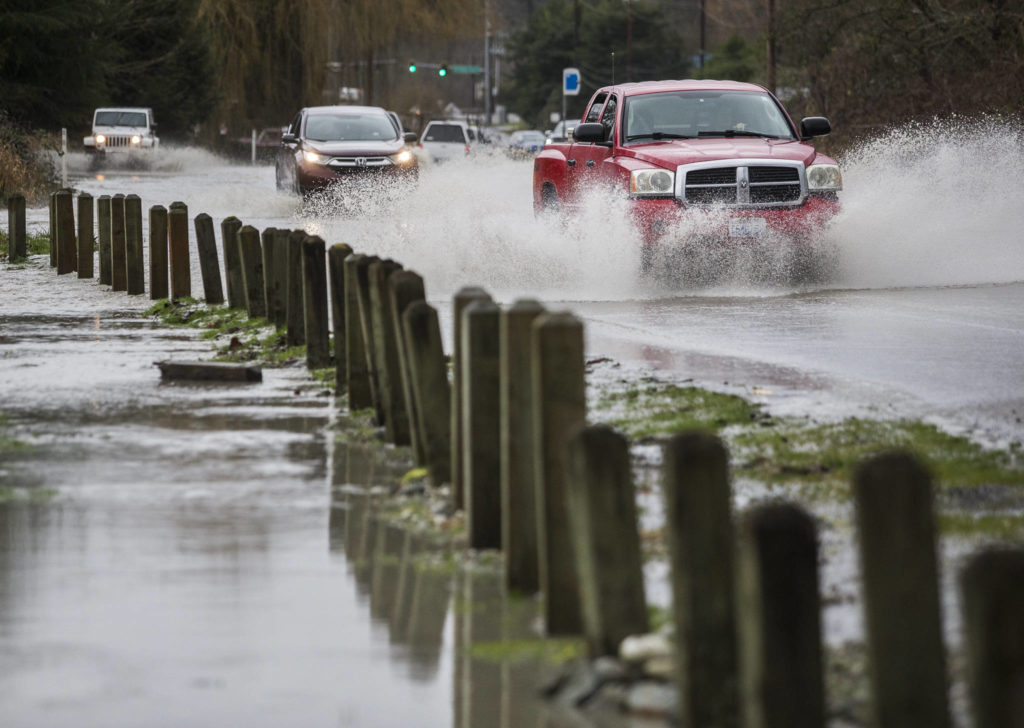SNOHOMISH — Still recovering from recent flooding, people in flood-prone areas should ready themselves for another round of heavy rainfall.
Just days after one deluge, between 3 and 6 inches of rain could hit Snohomish County by Friday. The Cascade Range might see more. Once again rivers could rise and flood, and landslide risk will increase.
“If people think it’s over, it’s not. This is flood season,” Snohomish County Department of Emergency Management spokesperson Scott North said.
Last week, 1.52 inches of rain fell in Snohomish alone, according to Washington State University’s AgWeatherNet. The United States Geological Survey’s gauge on the Snohomish River near Monroe measured the water at just above 6 feet early Friday. The gage height surged to 15 feet by the end of the day, topped out at more than 18 feet Saturday, and dropped to 16 feet Sunday.
As water moved from the mountains to the lowlands, debris created a logjam near the U.S. 2 trestle between Everett and Lake Stevens. Washington State Department of Transportation crews used a crane to break up the cluster and alleviate pressure on the piers.
“This one was nothing like that last one,” WSDOT spokesperson Lisa Van Cise said of a massive raft of branches, limbs, roots and trunks underneath the trestle in October.
With more flooding possible, the state will track flow under the highway.
“It’s one of those things that we monitor,” Van Cise said. “We’ll put the equipment out if it looks like the risk is there.”
Rain in the mountains also melted recent snowfall, further engorging the rivers.
Conditions could be similar to that this week, said Logan Johnson, a National Weather Service meteorologist.
“We’ll sort of get done with one system, but you won’t be able to tell,” he said.
Plenty of homes and property were damaged last week and dozens of roads were closed with dangerous water over them.
When someone comes upon a road with water over it, it’s best to find another way around. Otherwise a vehicle can get stuck and, in some dire cases, swept away. Depending on the flow, as little as a foot of water can overtake a vehicle, no matter how lifted it is. A Chevrolet Suburban isn’t an amphibious vehicle, after all.
“Don’t drive through standing water on the roads,” North said. “Crews are out putting up signs and closing roads, but they can’t be everywhere before drivers do.”
Those near a river or waterway that floods should prepare like they would for other natural disasters. Have food and water, batteries for lights, necessary medications, and warm, dry clothes.
People who commute from or to places where roads were closed last week should think about staying home or figuring out another way to get around.
“If their route takes them through areas that flood, identify an alternative, if at all possible,” North said.
Last week’s flooding created a bottleneck on U.S. 2 between Snohomish and Monroe, and parts farther east. A big part of that traffic was drivers forced from impassible side roads. Another factor was “flood tourists,” people who want to behold the majesty of a raging river.
Saturated ground can make soil unstable. Creek behavior changes, deformations in the ground, and the sound of trees snapping are just some of the signs that a landslide may be imminent.
Ben Watanabe: bwatanabe@heraldnet.com; 425-339-3037; Twitter @benwatanabe.
Talk to us
> Give us your news tips.
> Send us a letter to the editor.
> More Herald contact information.


























